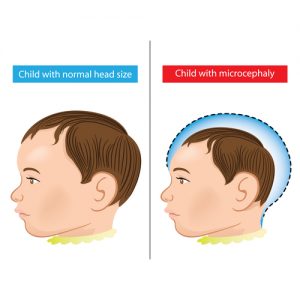Microcephaly

Key facts
- Microcephaly is a condition where a baby is born with a small head or the head stops growing after birth.
- Microcephaly is a rare condition. One baby in several thousand is born with microcephaly.
- The most reliable way to assess whether a baby has microcephaly is to measure head circumference 24 hours after birth, compare the value with WHO growth standards, and continue to measure the rate of head growth in early infancy.
- Babies born with microcephaly may develop convulsions and suffer physical and learning disabilities as they grow older.
- There are no specific tests to determine if a baby will be born with microcephaly, but ultrasound scans in the third trimester of pregnancy can sometimes identify the problem.
- There is no specific treatment for microcephaly.
Microcephaly is a condition where a baby has a head size much smaller compared with other babies of the same age and sex. Head size is an important measurement to monitor a child’s brain growth. The severity of microcephaly ranges from mild to severe. Microcephaly can be present at birth (congenital) or may develop postnatally (acquired).
Scope of the problem
Microcephaly is a rare condition. Reported estimate incidence of microcephaly has wide variation due to the differences in the definition and target population.
Increased number or clustering of cases of microcephaly have been reported in context of outbreaks of Zika virus infection. The most likely explanation of available evidence is that Zika virus infection during pregnancy is a cause of congenital brain abnormalities including microcephaly.
In addition to microcephaly, a range of manifestations of varying severity has been reported among newborns that were exposed to Zika virus in utero. These include malformations of the head, seizures, swallowing problems, hearing and sight abnormalities. Other outcomes associated with Zika virus infection in utero may involve miscarriages and stillbirths. Together, this spectrum is referred to as ‘congenital Zika virus syndrome.’
Diagnosis
Early diagnosis of microcephaly can sometimes be made by fetal ultrasound. Ultrasounds have the best diagnosis possibility if they are made at the end of the second trimester, around 28 weeks, or in the third trimester of pregnancy. Often diagnosis is made at birth or at a later stage.
Babies should have their head circumference measured in the first 24 hours after birth and compared with WHO growth standards. The result will be interpreted in relation to the gestational age of the baby, and also the baby’s weight and length. Suspected cases should be reviewed by a paediatrician, have brain imaging scans, and have their head circumference measured at monthly intervals in early infancy and compared with growth standards. Doctors should also test for known causes of microcephaly.
Causes of microcephaly
There are many potential causes of microcephaly, but often the cause remains unknown. The most common causes include:
- infections during pregnancy: toxoplasmosis (caused by a parasite found in undercooked meat), Campylobacter pylori, rubella, herpes, syphilis, cytomegalovirus, HIV and Zika;
- exposure to toxic chemicals: maternal exposure to heavy metals like arsenic and mercury, alcohol, radiation, and smoking;
- pre- and perinatal injuries to the developing brain (hypoxia-ischemia, trauma);
- genetic abnormalities such as Down syndrome; and
- severe malnutrition during fetal life.
Based on a systematic review of the literature up to 30 May 2016, WHO has concluded that Zika virus infection during pregnancy is a cause of congenital brain abnormalities, including microcephaly; and that Zika virus is a trigger of Guillain-Barré syndrome.
Signs and symptoms
Many babies born with microcephaly may demonstrate no other symptoms at birth but go on to develop epilepsy, cerebral palsy, learning disabilities, hearing loss and vision problems. In some cases, children with microcephaly develop entirely normally.
Treatment and care
There is no specific treatment for microcephaly. A multidisciplinary team is important to assess and care for babies and children with microcephaly. Early intervention with stimulation and play programmes may show positive impacts on development. Family counselling and support for parents is also extremely important.



No comments:
Post a Comment